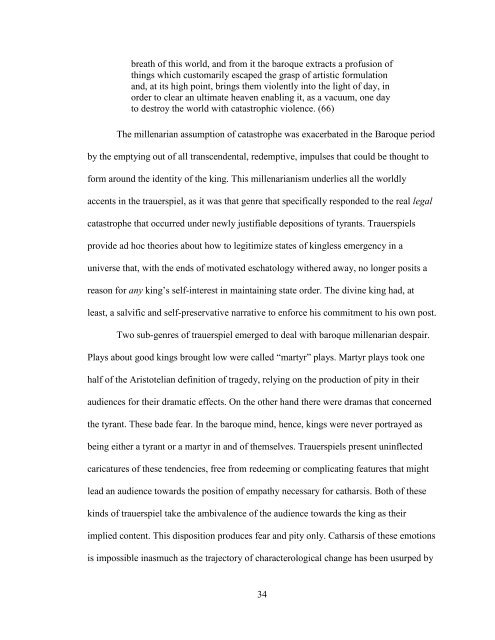TABOO: THE ACTUAL MODERNIST AESTHETIC, MADE REAL A ...
TABOO: THE ACTUAL MODERNIST AESTHETIC, MADE REAL A ...
TABOO: THE ACTUAL MODERNIST AESTHETIC, MADE REAL A ...
Create successful ePaper yourself
Turn your PDF publications into a flip-book with our unique Google optimized e-Paper software.
eath of this world, and from it the baroque extracts a profusion of<br />
things which customarily escaped the grasp of artistic formulation<br />
and, at its high point, brings them violently into the light of day, in<br />
order to clear an ultimate heaven enabling it, as a vacuum, one day<br />
to destroy the world with catastrophic violence. (66)<br />
The millenarian assumption of catastrophe was exacerbated in the Baroque period<br />
by the emptying out of all transcendental, redemptive, impulses that could be thought to<br />
form around the identity of the king. This millenarianism underlies all the worldly<br />
accents in the trauerspiel, as it was that genre that specifically responded to the real legal<br />
catastrophe that occurred under newly justifiable depositions of tyrants. Trauerspiels<br />
provide ad hoc theories about how to legitimize states of kingless emergency in a<br />
universe that, with the ends of motivated eschatology withered away, no longer posits a<br />
reason for any king‟s self-interest in maintaining state order. The divine king had, at<br />
least, a salvific and self-preservative narrative to enforce his commitment to his own post.<br />
Two sub-genres of trauerspiel emerged to deal with baroque millenarian despair.<br />
Plays about good kings brought low were called “martyr” plays. Martyr plays took one<br />
half of the Aristotelian definition of tragedy, relying on the production of pity in their<br />
audiences for their dramatic effects. On the other hand there were dramas that concerned<br />
the tyrant. These bade fear. In the baroque mind, hence, kings were never portrayed as<br />
being either a tyrant or a martyr in and of themselves. Trauerspiels present uninflected<br />
caricatures of these tendencies, free from redeeming or complicating features that might<br />
lead an audience towards the position of empathy necessary for catharsis. Both of these<br />
kinds of trauerspiel take the ambivalence of the audience towards the king as their<br />
implied content. This disposition produces fear and pity only. Catharsis of these emotions<br />
is impossible inasmuch as the trajectory of characterological change has been usurped by<br />
34
















